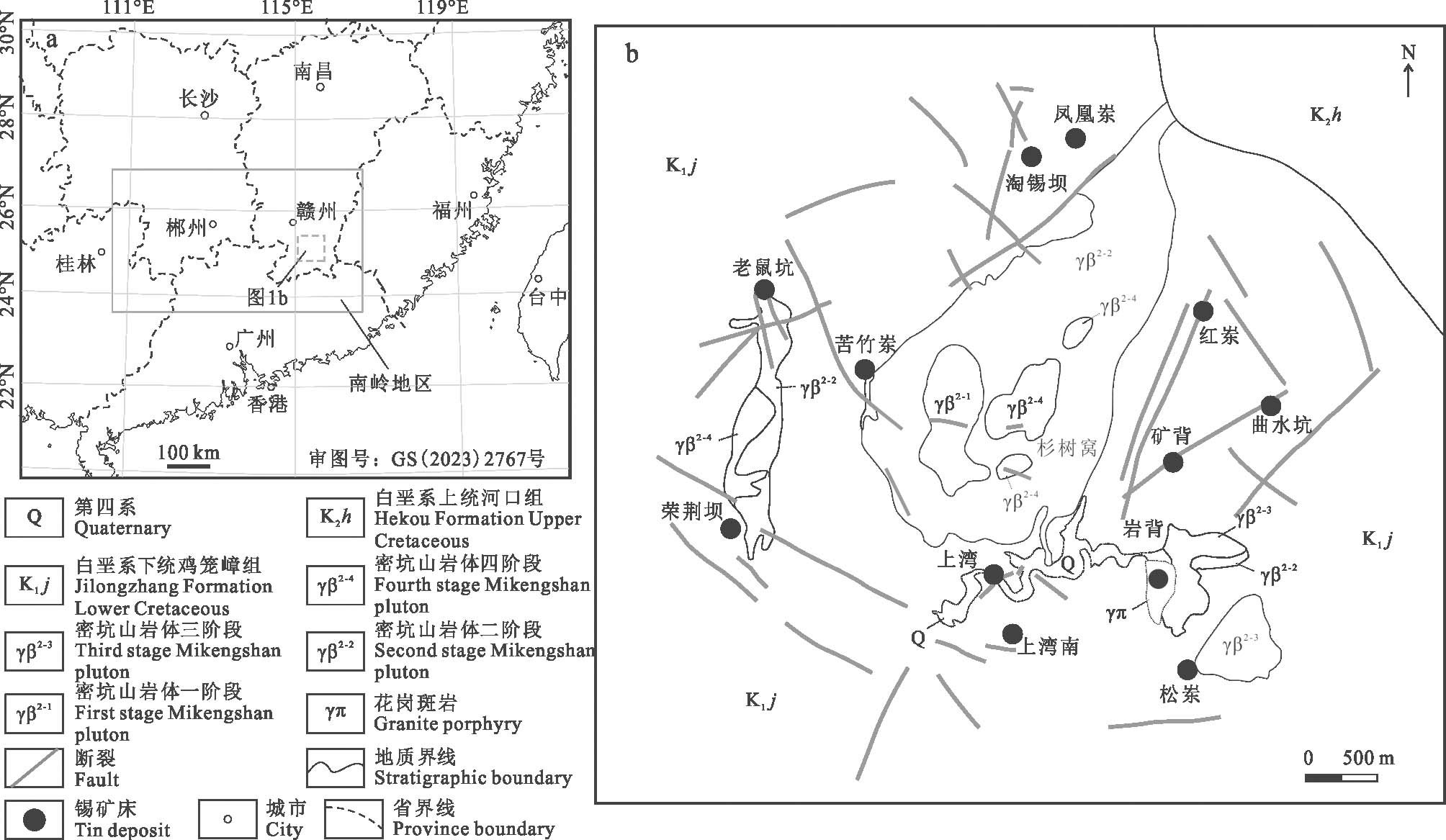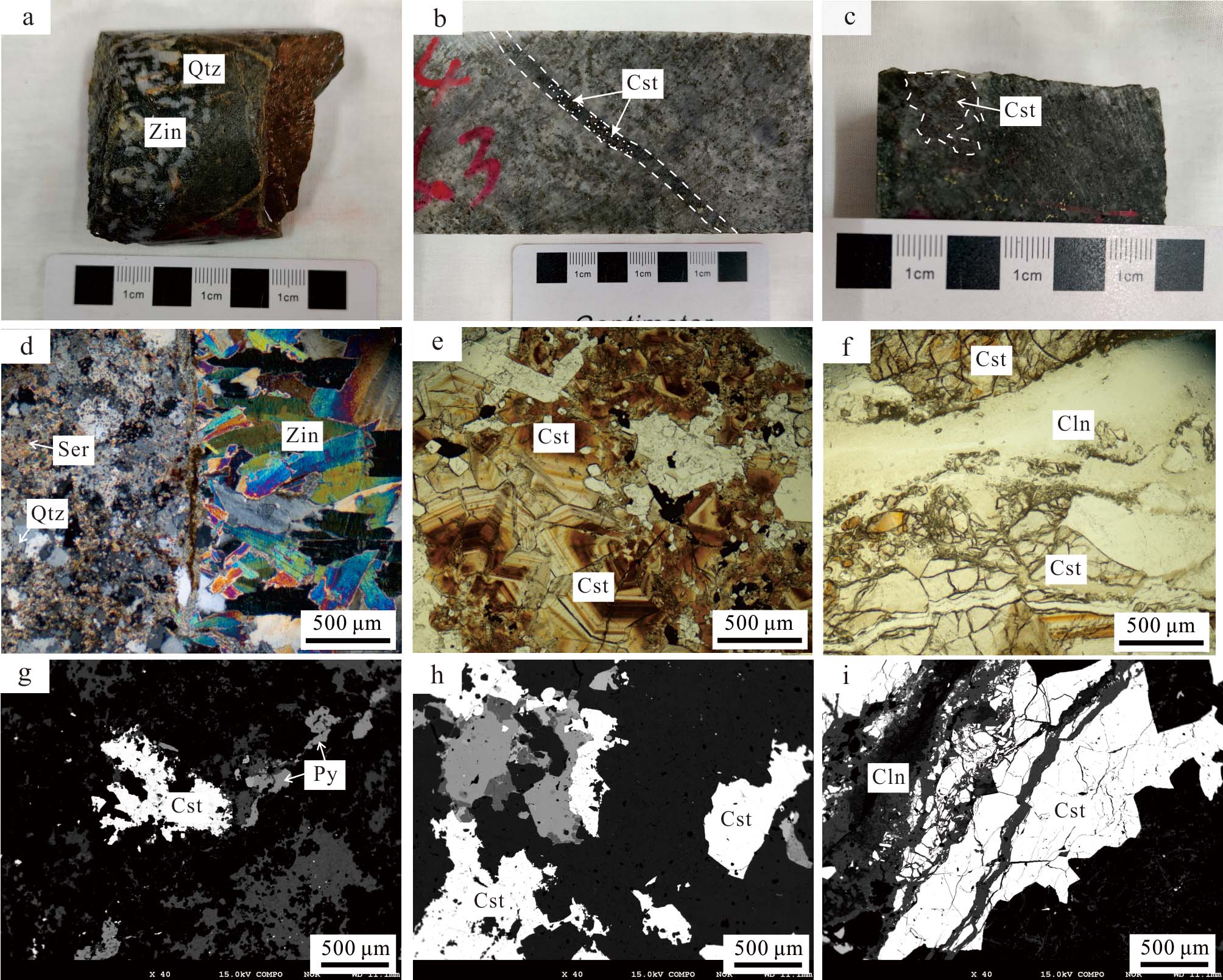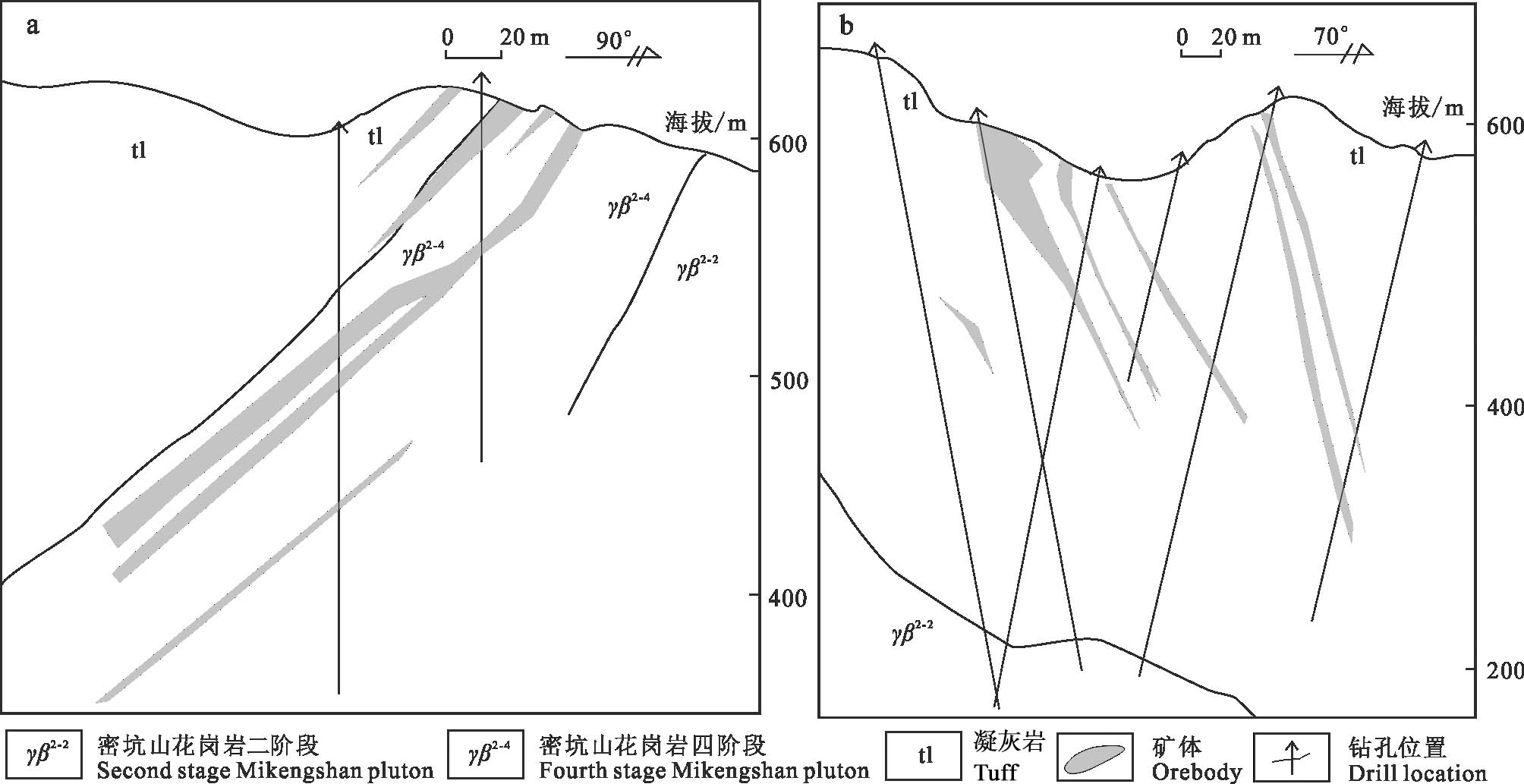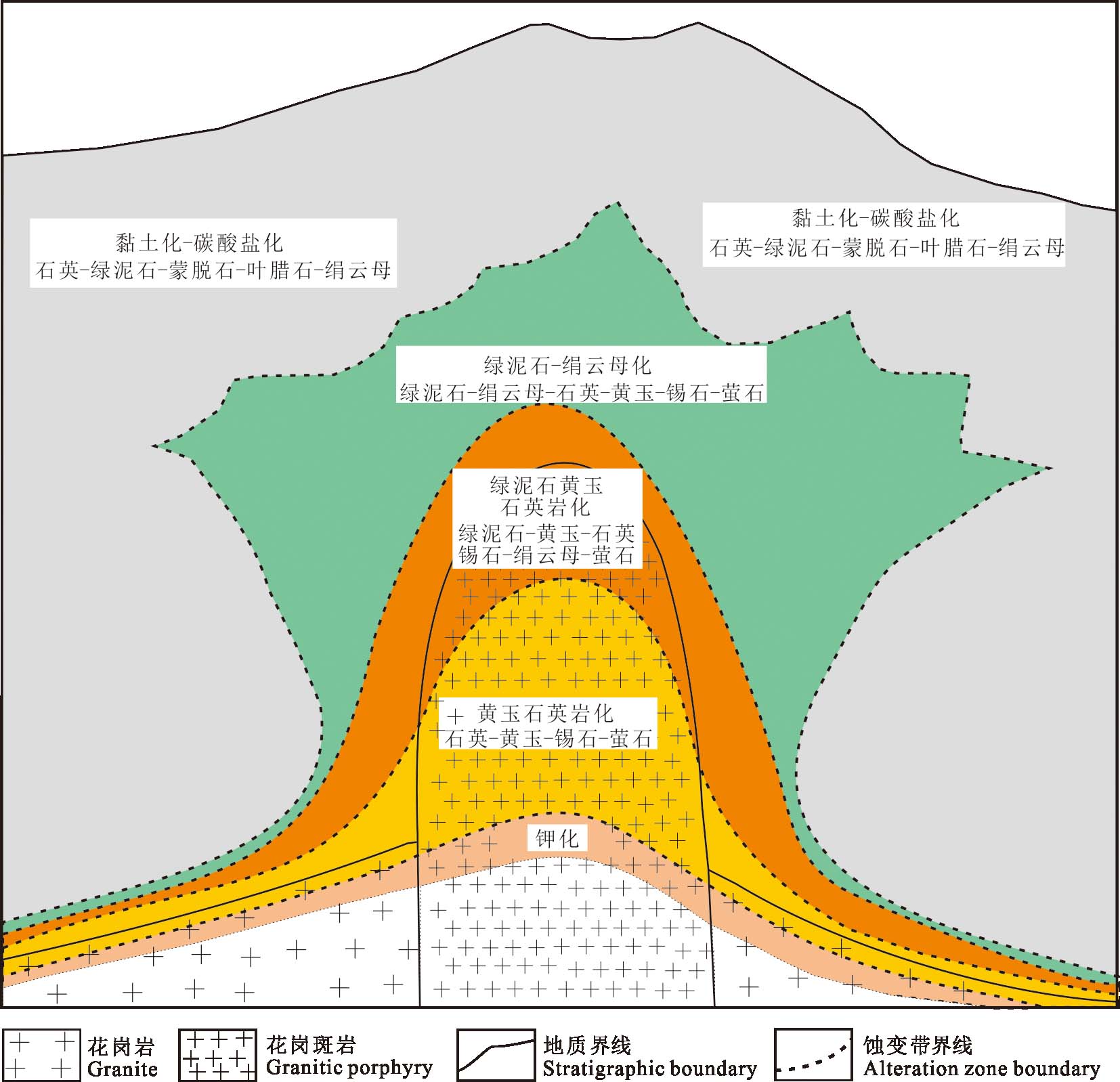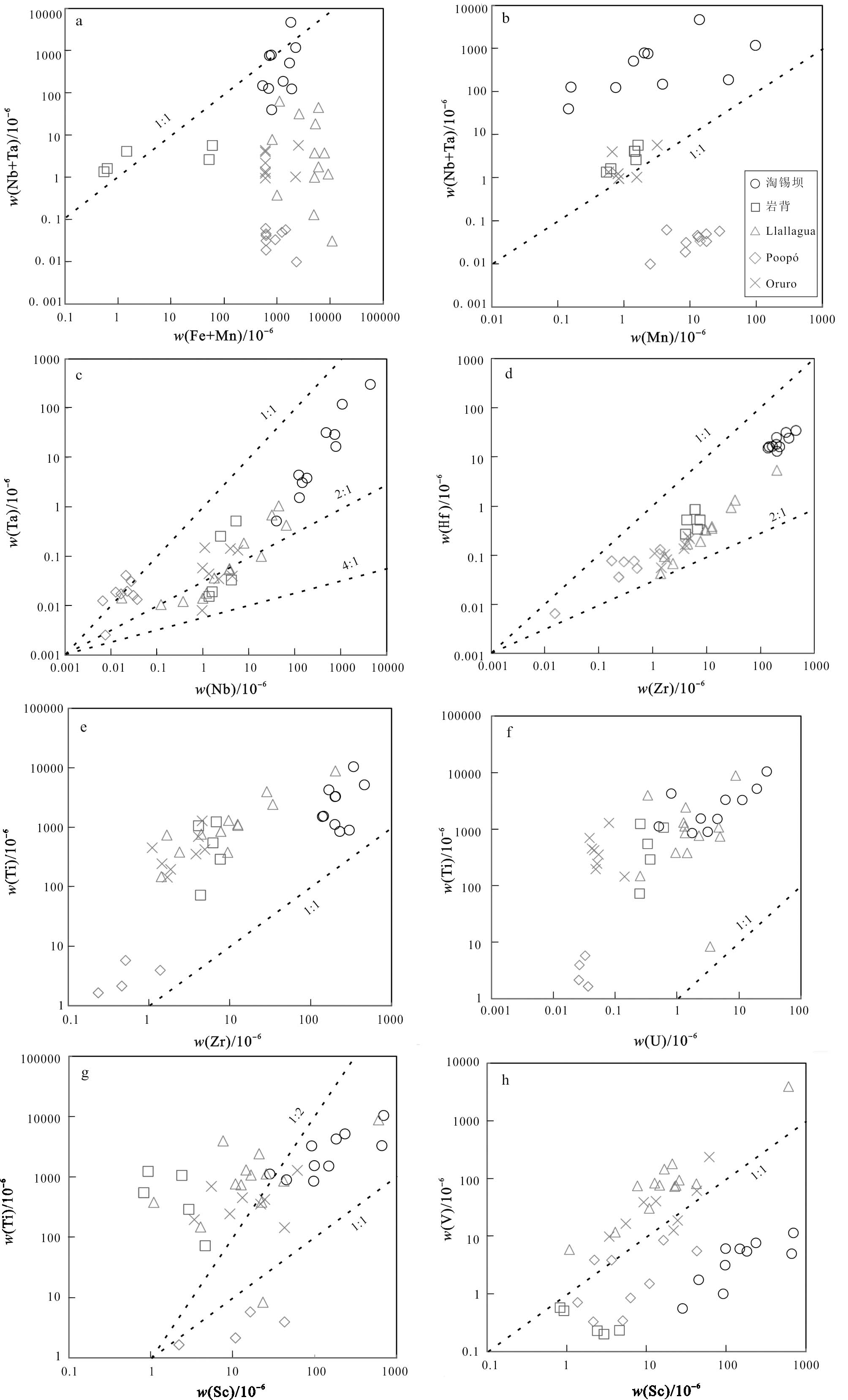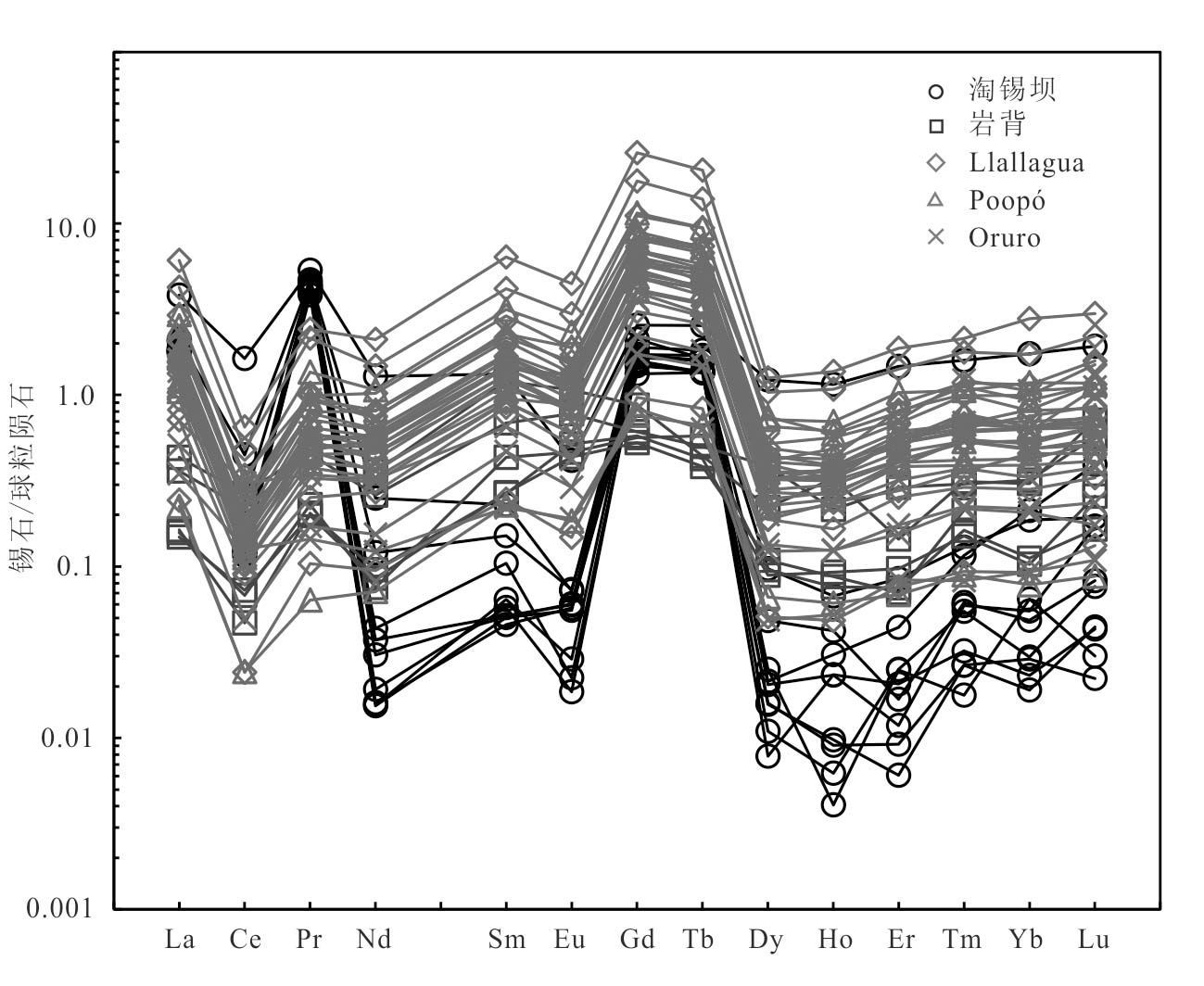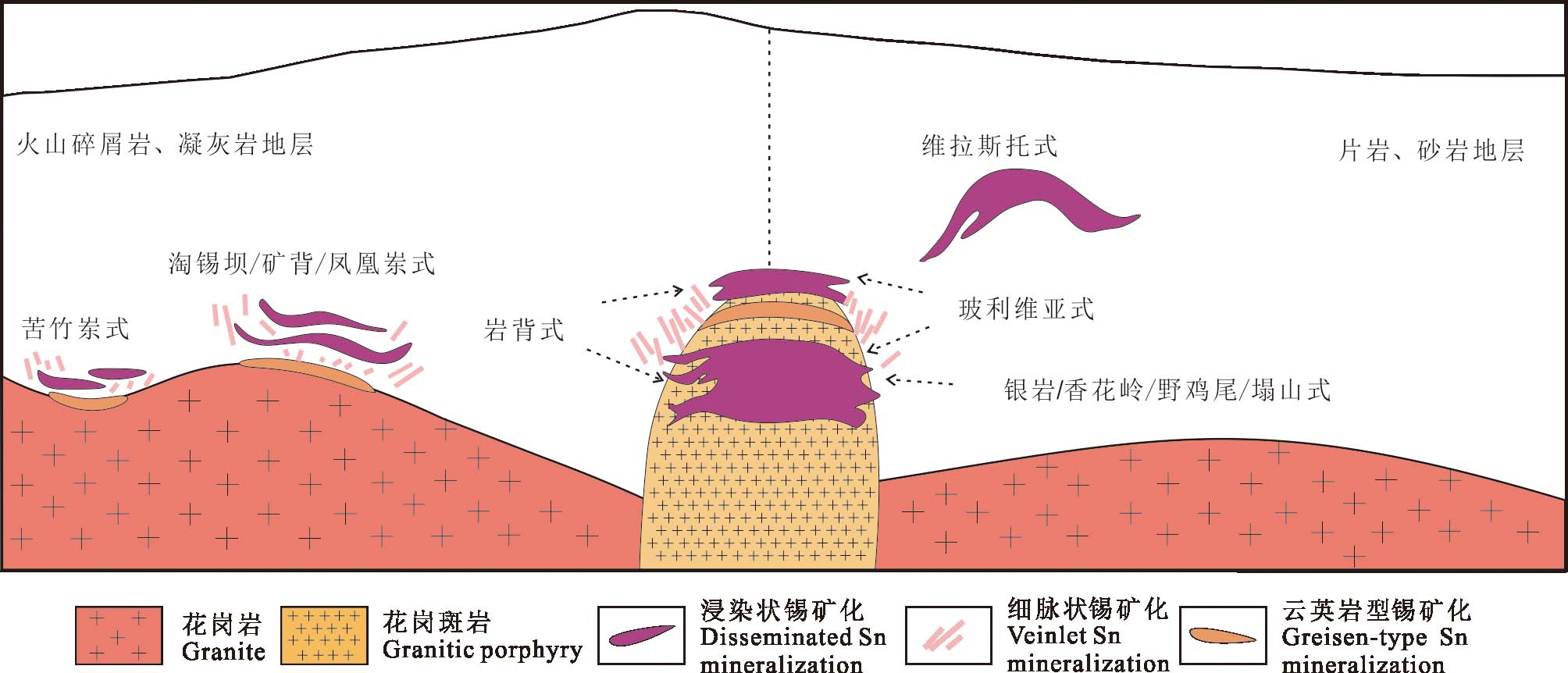-
自五千年前的青铜时代开始,锡在人类社会发展中一直发挥着重要作用,其对新材料、新能源、信息技术、航空航天、国防军工等高新技术产业和战略工业的发展至关重要(Mao et al., 2019; Yuan et al., 2019; Lehmann et al., 2021; Zhao et al., 2022)。斑岩型锡矿是全球锡资源重要类型之一,主要产于浅成岩浆/次火山环境(Grant et al., 1977; Lehmann et al., 1990; Dietrich et al., 2000)。斑岩型锡矿的主要产地有南美的玻利维亚、北美的加拿大、非洲的尼日利亚等(Sillitoe et al.,1975;Arce-Burgoa et al.,2009),著名矿床有Llallagua、Poopó和Huanuni等(Gemmrich et al., 2021;Betkowski., 2022)。中国典型的斑岩型锡矿有江西岩背、广东银岩、浙江洋滨和内蒙古维拉斯托等(关勋凡等,1985;朱正书,1990;沈渭洲,1994;Hu et al., 2021; Shi et al., 2021)。相较于斑岩型铜钼矿床,地质工作者们对斑岩型锡矿床的成矿结构和成矿机理尚缺乏系统认识(芮宗瑶等,1986;袁顺达等,2020),这也制约了该类型矿床的找矿突破。
江西会昌锡坑迳矿田在40 km2的范围内已发现了岩背和淘锡坝2个大型锡矿床,以及矿背、苦竹岽和凤凰岽等多个中型锡矿床(徐贻赣等,2001;Liu et al., 2021)。其中,岩背锡矿被公认为是斑岩型,淘锡坝矿床成因尚存争议(柳勇,2011;彭琳琳,2020),其余中型矿床的研究程度则较低。这些矿床在空间上存在明显的矿化分带,已有的研究显示,其成岩成矿时代基本一致(~133 Ma,Liu et al., 2021;Li et al., 2021)、矿化类型复杂且蚀变类型多样,是研究斑岩型锡成矿系统发育特征及找矿模型的理想区域。本文在详细的矿床地质调查和地质编录基础上,将锡坑迳锡矿田与国内外典型斑岩型锡成矿系统进行对比研究,并讨论了锡石地球化学特征对斑岩型锡成矿作用的指示意义,构建了锡坑迳斑岩型锡成矿系统的找矿模型,为华南锡矿床成因研究与找矿勘查工作提供新的理论依据。
1矿田地质概况锡坑迳锡矿田位于南岭成矿带东部与武夷山成矿带南西侧交汇部位(图1a)。区域出露的地层主要为白垩系上统河口组、白垩系下统鸡笼嶂组及第四系。其中,白垩系上统河口组为一套陆相碎屑岩建造,分布于矿田北东角,岩性为含砾粉砂岩、砂砾岩、粗砂岩、细砂岩、粉砂岩、砾岩等;白垩系下统鸡笼嶂组为一套流纹质火山碎屑-火山熔岩组合,岩性主要为凝灰熔岩、晶屑凝灰熔岩、流纹岩、熔结凝灰岩、集块岩、隐爆角砾岩等;第四系为冲洪积物及残坡积物,主要分布于上湾-岩背一带的沟谷中,岩性主要为亚黏土、亚砂土等。
区域构造活动发育,主要受NE-SW走向的石城-寻乌断裂系统控制,以断裂构造、火山构造最为发育。区内的断裂构造主要有EW向、NE向、NS向、NNE向及NW向断裂带。区内火山及次火山构造主要为密坑山破火山口构造,位于矿田中部,呈近椭圆状,主喷发中心已被密坑山岩体侵入。
区域上出露的岩浆岩主要为燕山晚期侵入的中酸性花岗岩,具多期活动的特点,包括大面积的似斑状花岗岩基(密坑山岩体)与较晚侵位的岩背花岗斑岩枝。密坑山岩体侵位于早白垩世鸡笼嶂组火山岩中,依其先后关系划分为4个阶段,分别为多斑巨粗斑细粒黑云母钾长花岗岩、(多斑)巨粗斑细粒黑云母花岗岩、中粗斑细粒黑云母花岗岩和(含斑)细粒黑云母花岗岩。岩背花岗斑岩枝主体呈NNW向的似椭圆体,局部以相变关系与密坑山岩体组成一体,为岩背锡矿成矿母岩。
2矿床地质锡坑迳矿田位于江西省会昌县南约45 km处,矿田内分布有岩背、淘锡坝、矿背、苦竹岽和凤凰岽等大中型锡矿床,并新发现了上湾、杉树窝和红岽等锡矿点(图1b)。
岩背锡矿位于锡坑迳矿田南东部,查明锡金属资源储量10.2万t,锡品位介于0.2%~1.5%(李雪琴等,2013)。锡矿化主要产于晶屑凝灰熔岩和花岗斑岩中,少量出现在密坑山(含斑)细粒黑云母花岗岩中。矿床已探明3个主要矿体,矿体总体走向5°~10°,倾向北西,倾角25°~30°,呈扁平透镜状或似层状展布(图2)。矿化类型包括浸染状、细脉浸染状及锡石-石英-黄玉-萤石脉状。其中,浸染状矿化主要集中在矿床的下部,产于花岗岩斑岩中,向上逐渐过渡为细脉浸染状,锡石-石英脉型矿化主要发育于矿床上部的晶屑凝灰熔岩中。矿床的热液蚀变包括硅化、黄玉化、白云母化、绢云母化、萤石化、绿泥石化和碳酸盐化。
图1锡坑迳矿田大地位置图(a)及地质矿产简图(b,据Liu et al., 2021)
Fig.1 The geographic location map(a) and distributions of granite intrusions and tin ore deposits of the Xikengjing Orefield(b,after Liu et al., 2021)
图2岩背矿床15号勘探线剖面(据熊小林,1994)
Fig.2 Geological cross section at exploration line No.15 through the Yanbei deposit(after Xiong, 1994)
图3淘锡坝矿床典型剖面(a,据徐贻赣等,2001)和矿背矿床100号勘探线剖面(b,据Liu et al., 2021)
Fig.3 Typical section through the Taoxiba tin deposit (a, after Xu et al., 2001) and geological cross section at exploration line No.100 through the Kuangbei deposit (b, after Liu et al., 2021)
图4淘锡坝矿床典型矿石手标本照片(a~c)、显微(d~f)照片及背散射照片(g~i)a、b. 脉状锡矿石;c. 浸染状锡矿石;d.绢云母化凝灰岩中发育石英-铁锂云母脉;e.锡石发育韵律环带;f.锡石被玉髓交代呈破碎状;g.锡石与黄铁矿细脉伴生产出;h.锡石与石英、黄铁矿伴生产出;i.锡石被玉髓交代呈破碎状Qtz—石英;Zin—铁锂云母;Cst—锡石;Ser—绢云母;Cln—玉髓;Py—黄铁矿
Fig.4 Field photographs (a~c), microphotographs (d~f) and backscattered electron (BSE) images (g~i) of typical ore samples from the Taoxiba deposita, b. Vein Sn ore; c. Disseminated Sn ore; d. The quartz-zinnwaldite vein cutting the sericite altered tuff; e. Oscillatory zoning of cassiterite;f. Cassiterite is fragmented by being replaced by chalcedony; g. Cassiterite and pyrite are paragenetic and distributed in veinlet; h. Thecoexistence of quartz, cassiterite and pyrite; i. Cassiterite is fragmented by being replaced by chalcedonyQtz—Quartz; Zin—Zinnwaldite; Cst—Cassiterite; Ser—Sericite; Cln—Chalcedony; Py—Pyrite
淘锡坝锡矿位于锡坑迳矿田北西部,查明锡金属资源储量5.88万t,锡品位介于0.2%~0.6%(徐贻赣等,2001)。矿体产于晶屑凝灰熔岩和(多斑)巨粗斑细粒黑云母花岗岩中。矿床已探明12个矿体,呈倾斜-缓倾斜的似层状产出(图3a)。矿化类型包括细脉浸染状、网脉状、锡石-石英脉型和云英岩型(图4a~i)。其中,前两种矿化类型集中于矿床中上部的晶屑凝灰熔岩中且均被锡石-石英脉型叠加切割,云英岩型发育于矿床下部的(多斑)巨粗斑细粒黑云母花岗岩中。矿区的蚀变主要有云英岩化、石英化、萤石化、黄玉化、绢云母化、绿泥石化等。
矿背锡矿位于锡坑迳矿田南东部,与岩背锡矿相近,已探明锡矿资源量2.3万t,锡平均品位为0.46%(Liu et al., 2021)。矿体主要赋存于(多斑)巨粗斑细粒黑云母花岗岩与晶屑凝灰岩中(图3b)。矿床已探明12个矿体,矿化类型包括细脉浸染状、锡石-石英脉型和云英岩型。其中,锡石-石英脉型为矿背矿床中最重要的矿化类型,产于矿床上部的晶屑凝灰岩和凝灰岩中。矿石主要由锡石组成,少量含有黄铜矿和黄铁矿,脉石矿物主要是石英、绿泥石、白云母和绢云母。
苦竹岽锡矿位于锡坑迳矿田西部,查明锡矿资源储量5758 t,锡平均品位为0.54%(彭琳琳,2020)。锡矿体产于(含斑)细粒黑云母花岗岩与凝灰岩的内外接触带,矿床已探明7个锡矿体,总体倾向西,往北倾向北西,倾角45°~55°(图5a)。锡石主要呈微细脉浸染状或集合体充填于裂隙中,或与石英、黄玉组成微脉穿切矿石,或以浸染状、星点状、局部聚集状散布于石英、绢云母的粒间。围岩蚀变种类主要有黄玉-石英岩化、绿泥石化、萤石化等。
凤凰岽锡矿位于锡坑迳矿田北部,与淘锡坝锡矿相邻,查明锡矿资源储量5919 t,锡品位介于0.7%~1.0%(彭琳琳,2020)。矿体产于凝灰岩与(多斑)巨粗斑细粒黑云母花岗岩外接触带裂隙中,矿体明显受断裂带控制,与围岩界线较清晰(图5b)。矿体走向NNW,倾向NEE,形态主要为囊状-楔形状,矿石矿物主要为锡石、黄铜矿及方铅矿,脉石矿物为石英、绢云母、绿泥石等。围岩蚀变主要为强绿泥石化、黄玉化-石英岩化。
3样品采集及测试方法本次工作系统采集淘锡坝矿床ZK100-1和ZK104-1钻孔岩芯样品25件,包括细脉浸染型锡矿化、铁锂云母-石英脉型锡钨矿化、含锡石矿化凝灰岩和硅化黄铁矿化凝灰岩等;采集岩背矿床200中段细脉浸染型锡矿化矿石样品5件。
图5苦竹岽矿床典型剖面(a,据张庆林等,2006)和凤凰岽矿床典型剖面(b,据彭琳琳等,2020)
Fig.5 Representative geologic sections through the Kuzhudong tin deposit (a, after Zhang et al., 2006) and Fenghuangdong tindeposit (b, after Peng et al., 2020)
电子探针分析和背散射图像(BSE)拍摄在中国地质科学院矿产资源研究所电子探针实验室进行,使用仪器为JXA-8230电子探针仪,设置加速电压为15 kV,电流为15 nA,束斑直径为1 μm,仪器的检测限制为0.01%~0.05%。测试元素包括SnO2、WO3、Cr3O3等,采用ZAF校正法。
锡石原位微量元素分析在国家地质实验测试中心完成,使用仪器为Agilent 8900串联四极杆ICP-MS (ICP-MS/MS),配合激光剥蚀系统为NWR193。实验采用He作为剥蚀物质的载气,激光束斑直径为40 μm、剥蚀时间为40 s、脉冲频率6 Hz、能量3 J,微量元素处理过程选用610作为外标。
4分析结果锡石电子探针测试数据见表1。淘锡坝矿床锡石w(SnO2)介于97.01%~99.87%,w(FeO)介于0.04%~0.20%,w(SiO2)介于0.59%~2.27%;岩背矿床锡石w(SnO2)介于98.52%~99.13%,w(FeO)介于0.02%~0.15%,w(SiO2)介于0.02%~0.54%。
锡石LA-ICP-MS微量元素数据见表2。淘锡坝矿床的锡石w(ΣREE)介于0.88×10-6~4.86×10-6,平均1.69×10-6;LREE/HREE值为1.91~2.69,平均2.29;(La/Yb)N值为2.20~98.68,平均38.35;Eu/Eu*=0.06~0.73,平均0.20;Ce/Ce*=0.04~1.03,平均0.18。岩背矿床锡石w(ΣREE)介于0.38×10-6~1.09×10-6,平均0.64×10-6;LREE/HREE范围1.01~1.95,平均1.34;(La/Yb)N范围1.13~1.58,平均1.39;Eu/Eu*=0.94~1.32,平均1.13;Ce/Ce*=0.26~0.59,平均0.43。
5讨 论5.1锡坑迳矿田锡多金属矿化蚀变结构锡矿化类型与成矿岩浆岩及围岩关系密切,也受成矿前、成矿期构造的共同制约(袁顺达等,2020;毛景文等,2023)。锡坑迳矿田内围绕燕山晚期似斑状黑云母花岗岩和花岗斑岩发育了岩背、淘锡坝、矿背、苦竹岽和凤凰岽等大中型锡矿床,矿田内早期形成的复杂断裂系统及岩浆晚期形成的诸如角砾岩筒、环状断裂、层间隐爆裂隙带等构造,为这些锡多金属矿床就位提供了有利的储矿空间。在很多斑岩型锡矿中,围岩蚀变类型及其发育程度有效的控制可矿化程度(徐耀鉴等,2015),划分围岩蚀变带并研究各蚀变带主要蚀变岩对认识蚀变与矿化的内在联系以及指导找矿勘探具有在重要的意义。
表1淘锡坝矿床和岩背矿床锡石电子探针分析结果(w(B)/%)
Table 1 Major element compositions of cassiterite from the Taoxiba and Yanbei deposits (w(B)/%)
组分
TXB-1
TXB-2
TXB-3
TXB-4
TXB-5
TXB-6
TXB-7
TXB-8
TXB-9
TXB-10
YB-1
YB-2
YB-3
YB-4
YB-5
SiO2
0.67
0.69
0.70
2.25
0.66
2.27
0.60
0.59
0.67
0.66
0.54
0.54
0.07
0.02
0.02
Al2O3
0
0
0
0.03
0.03
0
0
0
0
0.01
0.01
0
0
0.03
0
MgO
0.06
0.08
0.10
0.08
0.20
0.05
0.04
0.11
0.13
0.10
0.15
0.15
0.05
0.14
0.08
WO3
0.23
0
0
0.57
0
0.04
0
0.60
0
0
0
0
0
0
0
BaO
0.09
0.08
0.05
0.07
0.05
0.08
0.11
0.19
0.04
0.13
0
0
0
0
0
Ta2O5
0
0.18
0.05
0.05
0.04
0
0.20
0.15
0
0.13
0
0
0
0
0
Cr2O3
0.07
0
0
0.04
0.03
0
0
0.11
0.01
0
0
0
0
0
0
V2O3
0.19
0.01
0
0.13
0.15
0
0.04
0
0
0
0
0
0
0
0
FeO
0.85
0.76
0.29
0.22
0.04
0.07
0.24
0.36
0.28
0.23
0.07
0.08
0.42
0.67
0.58
TiO2
0.19
0.52
0.87
0.47
0.11
0.63
0.79
0
0.23
0.06
0.05
0.01
0.09
0.21
0.18
MnO
0
0
0
0
0.01
0
0.06
0.17
0
0
0
0
0
0
0.03
HfO2
0
0
0.12
0
0
0.06
0.05
0.36
0.02
0.07
0
0
0
0
0
Ga2O3
0.16
0
0.22
0.02
0.13
0.09
0.30
0
0.20
0.05
0
0
0
0
0
SnO2
97.01
98.06
98.90
98.94
99.77
99.49
98.98
99.14
98.65
99.87
99.13
98.52
98.66
98.52
98.88
Nb2O5
0.02
0.46
0.24
0.46
0
0.02
0.15
0
0
0.05
0
0
0
0
0
ZrO2
0.04
0
0
0.03
0.06
0.05
0.01
0.02
0
0.08
0
0
0
0
0
总和
99.58
100.84
101.54
103.36
101.28
102.85
101.57
101.8
100.23
101.44
99.95
99.3
99.29
99.59
99.77
斑岩锡矿床的蚀变矿物分带(组合)是多种类型、多期次或阶段蚀变矿化作用按一定顺序又彼此叠加或部分叠加的综合产物(图6)。通常发育于岩体内部蚀变主要有钾长石化、硅化、云英岩化、萤石化,围岩蚀变包括硅化、黄玉化、黄铁矿化、绿泥石化、萤石化、绢云母化、碳酸盐化等(熊小林,1994;柳勇,2011)。尽管存在复杂多样且相互叠加的蚀变类型,但不同蚀变过程形成的蚀变岩相在垂向上表现出清晰的分带性,如岩背矿床从岩体向外可划分为黄玉石英带、绿泥石-黄玉石英岩化带、绿泥石-绢云母化带和碳酸盐化带4个蚀变带(梅永文等,1994)。淘锡坝矿床由矿体到围岩,蚀变分带依次为黄玉石英绿泥石化、绿泥石绢云母化、黏土绢云母化(柳勇,2011)。银岩矿床蚀变分带自上而下为钾硅酸盐化、黄玉绢英岩化及绿泥石角岩化(关勋凡等,1985)。其中,与锡矿化关系最为密切的主要有黄玉石英岩化、黄玉石英绿泥石化,其次为云英岩化与萤石化。黄玉石英岩化带内常见锡石与黄玉集合体、黄玉与石英集合体、黄玉与白云母及石英集合体三者密切共生;黄玉石英绿泥石化内常见由黄玉、铁锂云母等交代形成叶片状、放射状集合体绿泥石,伴随较为强烈锡矿化并析出部分硫化物;云英岩化多发育于岩体顶部,带内见少量的黄玉、萤石、锡石及金属硫化物等;萤石化贯穿于整个热液蚀变过程的始终,各蚀变带均有萤石的零星分布,其多与石英组成团块状或脉状,或呈粒状分布于绿泥石集合体中。
与斑岩锡矿化有关的蚀变可分为气水-热液蚀变与热液蚀变,前者系与花岗斑岩或斑状(似斑状)花岗岩有关的面型蚀变,其蚀变类型多样且相互叠加构成了由下而上的环状分带特征;后者为发育于火山-次火山岩围岩中的热液期裂隙型线状蚀变,有黄玉石英化、绢云母化、绿泥石化、萤石化,碳酸盐化等(徐耀鉴等,2015)。因含矿斑岩岩浆源区与被侵入围岩岩性不一致,国内外不同斑岩型锡矿的矿床蚀变有所差异:中国华南地区斑岩型锡矿床以含有大量以氟为主的挥发组分为特点,以强烈的石英化、黄玉化和绢云母化为特征,同时伴随强烈的锡矿化,在岩体顶部常发育厚层黄石云英岩,在上覆围岩中发育微细脉或网脉状锡石-石英-黄玉脉,与此类似的还有俄罗斯的Deputatskoe斑岩型锡矿床(Seltmann et al., 2010;李真真等,2019);而玻利维亚Llallagua斑岩型锡矿以富含硼为特色,由于非挥发性的硼酸易在高盐度流体中富集,其较早交代围岩形成了大规模强电气石化带(Gemmrich et al., 2021;Betkowski., 2022),此后随着成矿流体温度和盐度的逐渐降低,在岩体上部发育了富含锡石的石英-绢云母化带。
表2淘锡坝矿床和岩背矿床锡石微量元素和稀土元素分析结果(w(B)/10-6)
Table 2 Trace elements and rare earth element compositions of cassiterite from the Taoxiba and Yanbei deposits (w(B)/10-6)
组分
TXB-1
TXB-2
TXB-3
TXB-4
TXB-5
TXB-6
TXB-7
TXB-8
TXB-9
TXB-10
YB-1
YB-2
YB-3
YB-4
YB-5
Y
0.06
0.03
0.03
0.06
0.03
1.52
0.03
0.02
0.04
0.03
0.06
0.07
0.04
0.04
0.08
Rb
4.12
0.47
0.05
0.11
0.05
20.31
0
0.01
0
0
0.49
0.42
0.24
0.21
0.29
K
0.49
0.76
0.55
0
0
2.05
0
0
0
0
0.01
0.01
0
0
0
Ba
23.76
22.30
22.19
23.45
23.50
24.39
23.56
22.86
23.26
23.07
2.53
2.87
0.89
0.64
1.02
Th
0.56
0
0.05
0.03
0.11
4.04
0.01
0.03
0
0
0.07
0.09
0.01
0.01
0.05
U
5.96
11.16
4.49
19.29
0.80
27.86
1.74
2.40
3.11
0.50
0.33
0.25
0.60
0.37
0.24
Nb
183.32
4400.40
144.64
777.48
731.14
1067.69
120.17
477.69
126.27
39.19
5.19
2.39
1.34
1.59
4.10
La
0.50
0.43
0.42
0.44
0.49
0.91
0.45
0.41
0.42
0.43
0.10
0.09
0.04
0.04
0.05
Ce
0.27
0.07
0.09
0.09
0.15
1.00
0.08
0.08
0.07
0.07
0.16
0.13
0.03
0.04
0.07
Sr
0.17
0.01
0.02
0.01
0.02
1.48
0.02
0.26
0
0.01
0.49
0.66
0.14
0.17
0.17
P
0
1.73
1.61
0.30
0.18
0.29
0.18
0.15
0.16
0.09
0
0.01
0
0
0.01
Zr
203.70
199.05
138.91
459.45
167.36
337.68
227.79
144.88
298.37
197.82
6.15
6.81
4.10
7.59
4.31
Hf
13.11
24.97
15.20
34.75
16.51
24.26
16.10
16.12
31.60
18.16
0.86
0.34
0.27
0.52
0.53
Sm
0.04
0.01
0.01
0.01
0.02
0.20
0.01
0.02
0.01
0.01
0.18
0.11
0.04
0.07
0.07
Ti
2.54
2.51
1.16
3.96
3.26
8.01
0.65
1.18
0.68
0.85
0
0
0
0
0
Pr
0.44
0.36
0.38
0.41
0.43
0.51
0.42
0.41
0.39
0.40
0.05
0.04
0.02
0.02
0.02
Nd
0.12
0.01
0.01
0.02
0.06
0.60
0.01
0.02
0.01
0.01
0.17
0.12
0.04
0.04
0.04
Sm
0.04
0.01
0.01
0.01
0.02
0.20
0.01
0.02
0.01
0.01
0.18
0.11
0.04
0.04
0.07
Eu
0
0
0
0
0
0.02
0
0
0
0
0.06
0.05
0.03
0.03
0.03
Gd
0.43
0.35
0.39
0.35
0.34
0.52
0.33
0.30
0.27
0.32
0.18
0.13
0.12
0.11
0.12
Tb
0.06
0.06
0.07
0.06
0.06
0.10
0.05
0.05
0.05
0.05
0.02
0.02
0.02
0.01
0.02
Dy
0.02
0.01
0.01
0.01
0.01
0.31
0
0
0
0
0.06
0.10
0.02
0.03
0.02
Ho
0
0
0
0
0
0.07
0
0
0
0
0.02
0.01
0
0
0
Er
0.01
0
0
0.01
0
0.24
0
0
0
0
0.02
0.05
0.02
0.01
0.01
Tm
0
0
0
0
0
0.04
0
0
0
0
0.01
0
0
0.01
0
Yb
0.03
0.01
0.01
0.04
0.01
0.30
0
0
0.01
0
0.05
0.05
0.02
0
0.02
Lu
0
0
0
0.01
0
0.05
0
0
0
0
0.02
0.01
0.01
0.01
0
5.2锡石地球化学特征及对成矿作用的指示由于Al3+、V3+、Sc3+、Zr4+、Hf4+、Ti4+、Nb5+、Ta5+等离子电荷、半径、配位数都与Sn4+相近,这些元素有可能在锡石的晶格结构替代锡的位置(Zhao et al., 2018; Cheng et al., 2019;Mao et al.,2020)。其中,正四价的阳离子(Zr4+、Hf4+和Ti4+)可以直接替代,而不同电荷的阳离子(如V3+、Sc3+和Nb5+)则需要通过耦合机制取代Sn4+(Cheng et al., 2019)。这些元素的替代特性在矿床成因研究和勘探中具有重要意义。锡石中微量元素的丰度可以反映矿物形成的环境,是判断其矿化类型的有效指标,其对温度有着很强的依赖关系(Murciego et al., 1997;Hennigh et al., 1999;Gemmrich et al., 2021)。尽管Nb和Ta被认为具有相似的地球化学行为,但两者的浓度和比例在锡石中会发生很大变化。由Nb-Ta图解(图7a~c)可以看出,来自锡坑迳地区与玻利维亚锡矿带的锡石样品在很大程度上沿着Nb∶Ta=2∶1分布,区别于岩浆锡石与云英岩型锡石Nb∶Ta=1∶1的分布。
Zr和Hf具有非常相似的地球化学行为,因此其通常保持接近于球粒陨石的Zr/Hf比值介于35~40(Hoskin et al., 2003)。然而,在热液环境和高度分异的火成岩中,可能会出现Zr/Hf比值的偏离,其可能的原因有交代作用、热液改造或与富集B、F流体中锆的优先迁移有关(Cheng et al., 2019;Gemmrich et al., 2021)。来自锡坑迳地区与玻利维亚锡矿带的锡石样品Zr/Hf比值明显发生了分馏现象(图7d),这与成矿过程中B和F的高活性相一致,表现为矿区内广泛分布的黄玉-萤石化和电气石化。在热液系统中,Sc在流体中以氟络合物的形式进行迁移(Plimer et al., 1991),锡石中Ti、Ti/Zr的减少被认为与从近端(高温)到远端(低温)位置的过渡有关,Ti/Zr和Ti/Sc比值可作为追踪岩浆热液中心的指标(Cheng et al., 2019)。来自热液中心近端的岩背矿床和Llallagua矿床的锡石样品具有比来自远端的Poopó和淘锡坝矿床的样品更高的Ti/Zr和Ti/Sc比值(图7e~g)。从Sc-V图(图7h)中可以明显看出,来自玻利维亚锡矿带的锡石样品大都位于Sc∶V=1∶1趋势线之上,而岩背矿床和淘锡坝矿床的锡石样品相比具有较低的V/Sc比值,这与后者成矿流体富氟的性质相吻合。
图6锡坑迳式斑岩型锡成矿系统蚀变结构模型
Fig.6 Alteration structure model of porphyry-type tin metallogenic system in Xikengjing
在锡石稀土元素球粒陨石标准化图解(图8)中,锡坑迳地区与玻利维亚锡矿带的锡石具有相似的分布模式,均显示La、Pr、Gd和Tb的正异常,和Ce与Eu的负异常。前人研究认为,玻利维亚锡矿带锡石样品的非规则REE曲线反映了矿床早期演化阶段与锡石沉淀阶段的普遍流体不相容(Monecke et al., 2011;Gemmrich et al., 2021)。淘锡坝矿床与岩背矿床锡石的REE配分曲线同样呈现不规则状,其可能是流体不混容作用引起的,这与淘锡坝矿床与岩背矿床的流体包裹体研究成果相印证(余长发等,2013;李前,2022)。综上所述,斑岩锡矿床矿质沉淀机制主要包括流体不混溶、流体沸腾和水岩反应;同一岩浆-热液系统中锡石的Ti/Zr和Ti/Sc比值可作为该区深部找矿的判别指标;不同大地构造背景下斑岩型锡成矿系统的成矿流体组成会有所差异(富F或富B),从而发育不同的矿化蚀变结构。
图7锡坑迳矿田和玻利维亚锡矿带锡石微量元素二元图(a~h,底图据Gemmrich et al., 2021;数据来源Gemmrich et al., 2021)
Fig.7 Correlation binary plots of trace elements in cassiterite after the Xikengjing district and Bolivian tin belt (a~h, base map after Gemmrich et al., 2021; data after Gemmrich et al., 2021)
图8锡坑迳矿田和玻利维亚锡矿带锡石稀土元素球粒陨石标准化图(标准化值据Sun et al., 1989;图中数据来源同图7)
Fig. 8 Chondrite-normalized REE patterns of cassiterite from the Xikengjing district and Bolivian tin belt (standardized data after Sun et al., 1989; the data sources in the figure is the same as Figure 7)
5.3锡坑迳斑岩型锡成矿系统地质模型斑岩型矿床是指规模很大、中低品位、矿化时空均与中酸性斑状侵入岩密切相关的内生金属矿床(Kirkham,1972),矿体形成深度相对较浅,一般不深于3~4 km,规模可达上百米(Seedorff,2005)。芮宗瑶等(1986)认为,斑岩型矿床的定义包括:① 与斑岩要有成因联系;② 矿体主要赋存于斑岩杂岩体和邻近的硅铝质围岩中;③ 矿石构造主要是细脉浸染状;④ 在同一深部机制支配下,随着上部矿石堆积的条件改变,斑岩型矿床可以与矽卡岩型、热液脉型、层控型以及火山有关的矿床共存于同一矿区或矿田;⑤ 通常矿石相对较贫,储量较大;⑥ 不受矿种限制,可以包括Cu、Mo、W、Sn、Au、U等金属。国际上判别是不是斑岩型矿床,最主要特点是细脉浸染状构造(Dietrich et al., 2000;毛景文等,2020)。相较于斑岩型铜钼矿床,中国对斑岩型锡矿床的研究程度较低,对于斑岩型锡矿床属于斑岩型矿床类型仍然有些疑虑,尚缺乏系统性判别标志,其主要原因在于,与成矿有关的侵入岩不是典型的斑状结构,而通常是似斑状结构。这一鲜明特点与锡坑迳矿田内侵入岩发育特征相吻合,矿田内除岩背地区揭露有花岗斑岩外,与淘锡坝、矿背及凤凰岽矿床成矿密切的花岗岩均表现为似斑状结构,这或是矿田内诸多矿床难以按成因类型划分,而在命名时选择强调成矿特点、矿化类型(“隐爆层间裂隙带型”、“破碎带蚀变岩型”)的关键所在(张庆林等,2006;李雪琴等,2013)。
燕山晚期,锡坑迳地区处于俯冲的古太平洋板块后撤所导致的岩石圈伸展背景下(Zhao et al., 2017;赵正等,2022;赵文等,2022),古元古代—中元古代地壳熔融产生的岩浆,经过比较充分的分离结晶演化出派生的富硅-钾质花岗岩浆,在频繁的上侵过程中沿火山机构及断裂侵入部或近地表(Liu et al., 2021)。由于岩体内富含Si、K、Al质及Sn、F、W等元素和残余气体,大量挥发组分和成矿元素在熔体上部不断聚集,按一定顺序对密坑山岩体和岩背花岗斑岩进行强烈交代,形成了面状蚀变矿化分带,锡石在的岩浆-热液过渡阶段结晶,并在岩体内部发育了大面积、大吨位、低品位的细脉浸染状锡矿石(李雪琴等,2013;Liu et al., 2021)。随着富挥发分成矿热液在岩浆室顶部进一步积累,最终引起气液沸腾,冲破边界向上运移,与此同时,岩浆晚期隐爆活动形成的诸如角砾岩筒、环状断裂、层间隐爆裂隙叠加于上覆白垩纪中酸性火山围岩早期断裂系统之上,形成了分布广泛的网脉状裂隙,通过这些裂隙,成矿流体与围岩交代,发育了微细脉浸染状、网脉状锡矿化。因此,岩背花岗斑岩代表了该复杂侵入体系统的较小的顶部部分,而密坑山花岗岩则构成了该复杂侵入体系统的主体部分。成矿系统成矿温度从岩浆中心向外递减,这解释了从近端浸染状锡矿化到远端微细脉浸染状和网脉状锡矿化的矿化分带,与锡石微量元素的指示相吻合。此外,由于岩体顶部与火山岩接触部位发生了云英岩化,在淘锡坝矿床与矿背矿床中除细脉浸染状锡矿化外,也发育了较少部分云英岩型锡矿化。综上所述,围绕密坑山杂岩体及岩背花岗斑岩的岩背、淘锡坝、矿背、凤凰岽和苦竹岽矿床共享约136~130 Ma的同一岩浆-热液锡矿系统(柳勇,2011;梁鹤,2017;Liu et al., 2021),各矿床矿化类型均以细脉浸染状为主,与成矿有关的花岗岩/花岗斑岩呈现出似斑状结构/斑状结构,产于浅成岩浆/次火山环境中,符合斑岩型锡矿的成矿特点。
笔者以锡坑迳地区为典型,建立了斑岩型锡成矿系统模式(图9)。与银岩、塌山及维拉斯托斑岩型锡矿床相比,锡坑迳地区由于密坑山富锡花岗岩与花岗斑岩的近同步侵位,不仅形成了较晚阶段的岩背斑岩型锡矿床,在其四周火山岩与锡坑迳岩体接触部位形成了淘锡坝、矿背、苦竹岽与凤凰岽锡矿床。这些矿床均以浸染状锡矿化为最主要的矿化类型,产于浅成岩浆/次火山环境中,共同构成了斑岩锡成矿系统。依据此找矿模型,可在密坑山岩体与上覆火山岩的内/外接触带构造发育强烈部位、不同方向断裂复合交叉部位、隐爆角砾岩发育地区和隐爆中心地区,以黄玉-石英-绢云母化带为找矿标志,进一步找寻隐伏锡矿体。此外,南岭地区除密坑山火山盆地外,还分布着许多早白垩世火山盆地,这一斑岩型锡成矿系统的建立,可为南岭地区下一步锡矿勘查提供依据。
图9斑岩型锡成矿系统矿化结构模型
Fig. 9 Mineralization structure model of porphyry-type tin metallogenic system
6结 论(1) 锡坑迳矿田围绕似斑状黑云母花岗岩和花岗斑岩发育一系列细脉浸染型、层间裂隙带型、云英岩型和破碎带型矿化,构成了特色的斑岩型锡成矿系统。该成矿系统经历了多期成矿作用,形成了复杂面状蚀变分带,包括黄玉石英带、绿泥石-黄玉石英岩化带、绿泥石-绢云母化带和黏土化-碳酸盐化带等,并存在相互叠加现象,这在富F斑岩型锡矿区或具有普适性。
(2) 锡坑迳矿田中锡石具有与玻利维亚锡矿带Llallagua、Poopó和Oruro相似的不规则REE配分曲线;微量元素均显示La、Pr、Gd和Tb的正异常,Ce和Eu的负异常以及Zr/Hf的分馏;岩背锡石较淘锡坝锡石具有高的Ti/Zr和Ti/Sc值,指示其更为靠近岩浆热液中心。
(3) 早白垩世,锡坑迳地区经历了连续的浅成-超浅成岩浆活动,岩浆演化形成了富挥发性组分的含锡成矿热液,矿液上侵就位于似斑状花岗岩和花岗斑岩与上覆火山岩接触带的角砾岩筒、环状断裂、层间隐爆裂隙中,形成了岩背、淘锡坝、矿背、苦竹岽和凤凰岽等以细脉浸染状和网脉状矿化为主的大-中型锡多金属矿床。以此,文章建立了斑岩型锡成矿系统矿化-蚀变结构模型,这对华南早白垩世火山盆地锡矿成因机制和勘查部署具有重要意义。
-
参考文献
Arce-Burgoa O and Goldfarb R J. 2009. Metallogeny of Bolivia[J]. SEG Discovery, 79(1): 1-15.
Betkowski W B, Rakovan J and Harlov D E. 2022. Geochronological characterization of Llallagua altered porphyry and hydrothermal vein assemblages from selected phosphate minerals and zircon[J]. Lithos, 410-411.
Cheng Y B, Spandler C, Kemp A, Mao J W, Rusk B, Hu Y and Blake K. 2019. Controls on cassiterite (SnO2) crystallization: Evidence from cathodoluminescence, trace-element chemistry, and geochronology at the Gejiu tin district[J]. American Mineralogist, 104: 118-129.
Dietrich A, Lehmann B and Wallianos A. 2000. Bulk rock and melt inclusion geochemistry of Bolivian tin porphyry systems[J]. Econ. Geol., 95 (2): 313-26.
Gemmrich L, Torró L, Melgarejo J C, Laurent O, Vallance J, Chelle-Michou C and Sempere T P A. 2021. Trace element composition and U-Pb ages of cassiterite from the Bolivian tin belt[J]. Miner Deposita, 56:1491-1520.
Grant J N, Halls C, Avila W and Avila G. 1977. Igneous geology and the evolution of hydrothermal systems in some sub-volcanic tin deposits of Bolivia[J]. Geological Society, London, Special Publication, 7 (1): 117-26.
Guan X F, Zhou Y Q, Xiao J H, Liang S Z and Li J M. 1985. Yinyan porphyry tin deposit: A new type of tin deposits in China[J]. Acta Geologica Sinica, 2:155-161+189(in Chinese).
Hennigh Q and Hutchinson R W.1999. Cassiterite at Kidd Creek: An example of volcanogenic massive sulfide-hosted tin mineralization[J]. Econ. Geol., 10: 431-440.
Hoskin P W O and Schaltegger U. 2003. The composition of zircon and igneous and metamorphic petrogenesis[J]. Reviews in Mine-ralogy and Geochemistry, 53 (1): 27-62.
Hu P C, Zhu W G, Zhong H, Zhao X Y and Mao W. 2021. Late Cretaceous granitic magmatism and Sn mineralization in the giant Yinyan porphyry tin deposit, South China: Constraints from zircon and cassiterite U-Pb and molybdenite Re-Os geochronology[J]. Miner Deposita, 56: 743-765.
Kirkham R V. 1972. The porphyry copper deposit at El salvador, Chile[J]. Econ. Geol., 67(8):1216-1243.
Lehmann B, Ishihara S, Michel H, Miller J, Rapela C, Sanchez A, Tistl M and Winkelmann L. 1990. The Bolivian tin province and regional tin distribution in the Central Andes: A reassessment[J]. Econ. Geol., 5: 4-58.
Lehmann B. 2021. Formation of tin ore deposits: A reassessment[J]. Lithos, 402-403: 105756.
Li Q, Zhao K D, Palmer M R, Chen W and Jiang S Y. 2021. Exploring volcanic-intrusive connections and chemical differentiation of high silica magmas in the Early Cretaceous Yanbei caldera complex hosting a giant tin deposit, Southeast China[J]. Chemical Geology, 584:120501.
Li Q. 2022. Early Cretaceous tin mineralization in southern Jiangxi Province and eastern Guangdong Province, China[D]. Wuhan: China University of Geosciences.
Li X Q, Zhao Y P, Wu Z C and Xu M L.2013. Study on metallogenic regularity of Xikengjing tin ore field in Huichang County, Jiangxi Province[J]. East China Geology, 34(2):109-115(in Chinese with English abstract).
Li Z Z, Qin K Z, Zhao J X, Li G M and Su S Q. 2019. Basic characte-ristics, research progresses and prospects of Sn-Ag-basemetal metallogenic system[J]. Acta Petrologica Sinica, 35(7): 1979-1998(in Chinese with English abstract).
Liang H. 2017. Cretaceous porphyries associated with the porphyry tin deposit in the Yanbei area, South China: Petrogenesis and implications for mineralization[D]. Guangzhou: Guangzhou Institute of Geochemistry, Chinese Academy of Sciences(in Chinese with English abstract).
Liu P, Mao J W, Lehmann B, Peng L L, Zhang R Q, Wang F Y, Lu G A and Jiang C Y. 2021. Cassiterite U-Pb dating of the Lower Cretaceous Yanbei tin porphyry district in the Mikengshan volcanic basin, SE China[J]. Ore Geology Reviews, 134: 104151.
Liu Y. 2011. Study on geological characteristics and genesis of Taoxiba tin deposit in Huichang, Jiangxi Province[D]. Beijing: China University of Geosciences (Beijing).
Mao J W, Ouyang H G, Song S W, Santosh M, Yuan S D, Zhou Z H, Zheng W, Liu H, Liu P, Cheng Y B and Chen M H. 2019. Geology and metallogeny of tungsten and tin deposits in China[J]. Economic Geology (Special Publications), 22: 411-482.
Mao J W, Wu S H, Song S W, Dai P, Xie G Q, Su Q W, Liu P, Wang X G, Yu Z Z, Chen X Y and Tang W X. 2020. The world-class Jiangnan tungsten belt: Geological characteristics, metallogeny, and ore deposit model[J]. Chinese Science Bulletin,65:3746-3762(in Chinese with English abstract).
Mao J W, Song S W, Liu P, Liu M, Zhao P L and Yuan S D. 2023. Current progress and development trend of the research on tin depo-sits[J]. Acta Petrologica Sinica, 39(5): 1233-1240(in Chinese with English abstract).
Mao W, Zhong H, Yang J H, Tang Y W, Liu L, Fu Y Z, Zhang X C, Sein K, Soe M A, Li J and Zhang L. 2020. Combined zircon, molybdenite, and cassiterite geochronology and cassiterite geoche-mistry of the Kuntabin tin-tungsten deposit in Myanmar[J]. Econ. Geol., 115(3): 603-625.
Mei Y W. 1994. Geological features and predictive criteria of the Yanbei porphyry Sn-deposits[J].Geology and Exploration, 30(1): 13-19(in Chinese with English abstract).
Monecke T, Kempe U, Trinkler M, Thomas R, Dulski P and Wagner T. 2011. Unusual rare earth element fractionation in a tin-bearing magmatic-hydrothermal system[J]. Geology, 39 (4): 295-298.
Murciego A, Sanchez A G, Dusausoy Y, Pozas J M and Ruck R. 1997. Geochemistry and EPR of cassiterites from the Iberian Hercynian Massif[J]. Mineralogical Magazine, 61(3): 357-365.
Peng L L, Chen W, Lu G A and Zeng D H. 2020. Geological characte-ristics and metallogenic regularity of Xikengjing ore deposits in Huichang, Jiangxi Province[J]. Journal of East China University of Technology(Natural Science), 43(3): 201-213(in Chinese with English abstract).
Plimer I R, Lu J and Kleeman J D.1991. Trace and rare earth elements in cassiterite-sources of components for the tin deposits of the Mole granite, Australia[J]. Mineral Deposita, 26: 267-274.
Rui Z Y and Zhang S T. 1986. Porphyry deposit series of China[J]. Acta Geoscientica Sinica, 3: 89-100(in Chinese).
Seedorff E, Dilles J H, Proffett Jr J M, Einaudi M T, Zurcher L, Stavast W J A, Johnson D A and Barton M D. 2005. Porphyry deposits: Characteristics and origin of hypogene features[A]. One Hundredth Anniversary Volume[C]. Society of Economic Geologists.
Seltmann R, Soloviev S, Shatov V, Pirajno F, Naumov E and Cherkasov S. 2010. Metallogeny of siberia: Tectonic, geologic and metallogenic settings of selected significant deposits[J]. Australian Journal of Earth Sciences: An International Geoscience Journal of the Geological Society of Australia, 57 (6): 655-706.
Shen W Z, Liu C S, Min M Z, Wang X F and Wang De Zi.1994. An isotope geologic study of the Yangbin porphyry tin deposit, Zhejiang Province[J]. Mineral Deposits, 13(2): 186-192(in Chinese with English abstract).
Shi R Z, Zhao J X, Evans N J, Qin K Z, Wang F Y, Li Z Z, Han R and Li X H. 2021.Temporal-spatial variations in Li-Fe mica compositions from the Weilasituo Sn-polymetallic deposit(NE China): Implications for deposit-scale fluid evolution[J]. Ore Geology Reviews, 134: 104132.
Sillitoe R H, Halls C and Grant J N. 1975. Porphyry tin deposits in Bolivia[J]. Econ. Geol., 70: 13-27.
Sun S S and McDonough W F. 1989. Chemical and isotopic systema-tics of oceanic basalts: Implications for mantle composition and processes[A]. In: Sanders A D and Norry M J, eds. Magmatism in Ocean Basins[C]. Geological Society, London, Special Publication, 42(1): 313-345.
Xiong X L, Zhu J C, Liu C S and Shen W Z.1994. Alteration zoning of the Yanbei porphyry tin deposit in Jiangxi Province and geochemical characteristics of its main altered rocks[J]. Mineral Deposits, 13(1): 1-10(in Chinese with English abstract).
Xu Y G, Xu J X and Liu K L. 2001. The Taoxiba tin deposit, Huichang, Jiangxi: Its geological features, genesis and ore-searching significance[J]. Jiangxi Geology, 15(2):119-124(in Chinese with English abstract).
Xu Y J, Yin H and Huang M X. 2015. Study of the Alteration minera-lization characteristics of porphyry tin deposit in Xianghualing ore field of Hunan[J]. Value Engineering, 33: 177-179(in Chinese with English abstract).
Yu Z F, Zhao H J, Xu L G, Sun J, Liu Y and Zhang L C. 2013. Characteristics of fluid inclusions and mineralization in Yanbei tin depo-sit, in Jiangxi Province[J]. Mineral Deposits, 32(2): 280-288(in Chinese with English abstract).
Yuan S D, Williams-Jones A E, Romer R L, Zhao P L and Mao J W. 2019. Protolith-related thermal controls on the decoupling of Sn and W in Sn-W metallogenic provinces: Insights from the Nanling region, China[J]. Econ. Geol., 114(5): 1005-1012.
Yuan S D, Zhao P L and Liu M. 2020. Some problems involving in petrogenesis and metallogenesis of granite-related tin deposits[J]. Mineral Deposits, 39(4): 607-618(in Chinese with English abstract).
Zhang Q L and He G H. 2006. The geological characteristics of Kuzhudong tin ore deposit and the combination of prospecting and mining in Huichang, Jiangxi Province[J]. Journal of East China University of Technology(Natural Science), S(1): 167-171(in Chinese with English abstract).
Zhao P L, Chu X, Williams-Jones A E, Mao J W and Yuan S D. 2022. The role of phyllosilicate partial melting in segregating tungsten and tin deposits in W-Sn metallogenic provinces[J]. Geology, 50(1): 121-125.
Zhao W and Zhang H J. 2022. Geochemical characteristics of skarn minerals and causative granites of the Xianglushan tungsten skarn deposit, Jiangxi, South China[J]. Acta Petrologica Sinica, 38(2): 483-494(in Chinese with English abstract).
Zhao W W, Zhou M F, Li Y H M, Zhao Z and Gao J F. 2017. Genetic types, mineralization styles, and geodynamic settings of Mesozoic tungsten deposits in South China[J]. Journal of Asian Earth Sciences, 137: 109-140.
Zhao W W and Zhou M F. 2018. Mineralogical and metasomatic evolution of the Jurassic Baoshan scheelite skarn deposit, Nanling, South China[J]. Ore Geology Reviews, 95: 182-194.
Zhao Z, Chen Y C, Wang D H, Li J K, Liu S B, Chen Z Y, Guo C L and Wang P A. 2022. Transformation of Mesozoic dynamic systems and superposition of metallogenic series of W-Sn-Li-Be-Nb-Ta-REE mineral deposits in South China[J]. Acta Petrologica Sinica, 38(2): 301-322(in Chinese with English abstract).
Zhu Z S.1990. Geological features and metallogenic type of the Yanbei tin deposit in Huichang County, Jiangxi Province[J]. Mineral Deposits, 9(4): 325-331(in Chinese with English abstract).
附中文参考文献
关勋凡,周永清,肖敬华,梁树钊,李金茂. 1985.银岩斑岩锡矿-中国锡矿床的一种新类型[J].地质学报, 2:155-161+189.
李前.2022.中国赣南-粤东早白垩世锡成矿作用研究[D].武汉:中国地质大学.
李雪琴,赵运平,吴正昌,徐敏林. 2013.江西会昌锡坑迳锡矿田成矿规律研究[J].资源调查与环境, 34(2): 109-115.
李真真,秦克章,赵俊兴,李光明,苏仕强.2019.锡-银多金属成矿系统的基本特征、研究进展与展望[J].岩石学报, 35(7): 1979-1998.
梁鹤. 2017.华南白垩纪岩背斑岩锡矿成矿斑岩的成因及其成矿意义[D].广州:中国科学院大学(中国科学院广州地球化学研究所).
柳勇. 2011.江西会昌淘锡坝锡矿床地质地球化学特征与矿床成因研究[D].北京:中国地质大学.
毛景文,吴胜华,宋世伟,戴盼,谢桂青,苏蔷薇,刘鹏,王先广,余忠珍,陈祥云,唐维新. 2020.江南世界级钨矿带:地质特征、成矿规律和矿床模型[J].科学通报, 65: 3746-3762.
毛景文,宋世伟,刘鹏,刘敏,赵盼捞,袁顺达. 2023.锡矿床研究现状及发展趋势[J].岩石学报, 39(5): 1233-1240.
梅勇文. 1994.岩背斑岩型锡矿床地质特征与预测标志[J].地质与勘探, 30(1): 13-19.
彭琳琳,陈伟,卢国安,曾德华. 2020.江西会昌锡坑迳矿田地质特征及成矿规律分析[J].东华理工大学学报(自然科学版), 43(3):201-213.
芮宗瑶,张洪涛. 1986.试论中国斑岩型矿床系列[J].中国地质科学院院报, 3: 89-100.
沈渭洲,刘昌实,闵茂中,王学锋,王德滋.1994.浙江洋滨斑岩锡矿的同位素地质研究[J].矿床地质, 13(2): 186-192.
熊小林,朱金初,刘昌实,沈谓洲. 1994.江西岩背斑岩锡矿蚀变分带及其主要蚀变岩的地球化学特征[J].矿床地质,13(1): 1-10.
徐耀鉴,尹灏,黄满湘. 2015.湖南香花岭矿田斑岩型锡矿的蚀变矿化特征研究[J].价值工程, 33: 177-179.
徐贻赣,许建祥,刘孔隆. 2001.会昌县淘锡坝锡矿地质特征、成因初探及找矿意义[J].江西地质, 15(2): 119-124.
余长发,赵海杰,徐林刚,孙嘉,柳勇,张立成. 2013.江西岩背锡矿床流体包裹体特征与成矿作用研究[J].矿床地质, 32(2): 280-288.
袁顺达,赵盼捞,刘敏. 2020.与花岗岩有关锡矿成岩成矿作用研究若干问题讨论[J].矿床地质, 39(4): 607-618.
张庆林,何桂红. 2006.江西省会昌县苦竹岽锡矿地质特征及矿山探(采)结合初探[J].东华理工学院学报, S(1): 167-171.
赵文,张怀瑾. 2022.江西香炉山钨矿床矽卡岩矿物和成矿花岗岩地球化学特征及其指示意义[J].岩石学报, 38(2): 483-494.
赵正,陈毓川,王登红,李建康,刘善宝,陈振宇,郭春丽,王平安. 2022.华南中生代动力体制转换与钨锡锂铍铌钽稀土矿床成矿系列的叠加演化[J].岩石学报, 38(2): 301-322.
朱正书. 1990.江西会昌岩背锡矿床地质特征及矿床类型的划分[J].矿床地质, 9(4): 325-331.
摘要
锡坑迳矿田位于南岭成矿带东段与武夷山成矿带交会部位,以早白垩世连续的岩浆喷发-侵入活动与多类型锡多金属成矿作用为特色。矿田内围绕似斑状花岗岩和花岗斑岩发育了岩背斑岩型、淘锡坝和矿背隐爆层间裂隙带型、苦竹岽和凤凰岽云英岩-破碎带蚀变岩型等大中型锡矿床。这些矿床的矿化-蚀变特征可与玻利维亚锡矿带、银岩、维拉斯托和洋滨等国内外斑岩型锡矿床类比,又独具特色,是研究斑岩型锡成矿系统发育特征与找矿模型的理想区域。文章在详细的野外地质调查基础上,系统总结了锡坑迳矿田内各类锡多金属矿化组合特征和蚀变结构,并对岩背矿床和淘锡坝矿床锡石开展了电子探针和LA-ICP-MS原位微区分析。研究结果显示,所有锡石样品均具有La、Pr、Gd和Tb的正异常、Ce与Eu的负异常、明显的Zr/Hf分馏和不规则的稀土元素配分模式,指示成矿热液早期阶段及锡石沉淀阶段经历了流体不相容。岩背锡石较淘锡坝锡石具有高的Ti/Zr和Ti/Sc比值,指示其更为靠近矿化中心。笔者研究认为,锡坑迳斑岩型锡成矿系统矿化类型包括细脉状、浸染状和细网脉状,围岩蚀变由早到晚、由成矿中心向外依次发育黄玉石英带、绿泥石-黄玉石英岩化带、绿泥石-绢云母化带和黏土化-碳酸盐化带。与斑岩型铜钼成矿系统相比,其成矿岩浆岩不仅有花岗斑岩,还有似斑状黑云母花岗岩,矿体在斑岩、花岗岩及上覆火山岩中均有赋存。相较于玻利维亚斑岩型锡成矿带发育的大面积石英-电气石化,锡坑迳斑岩成矿系统更富F,蚀变矿物中出现了大量黄玉、萤石和白云母等。对比国内外典型锡矿床的矿化-蚀变结构和锡石矿物学特征,文章建立了锡坑迳式斑岩型锡成矿系统的找矿模型。
Abstract
The Xikengjing ore field is located at the intersection of the eastern part of the Nanling metallogenic belt and the Wuyishan metallogenic belt. It is characterized by early Cretaceous magma eruption-intrusion activities and multi-type tin polymetallic mineralization. In the ore field, different types of large and medium-scale tin deposits such as Yanbei (porphyry type), Taoxiba and Kuangbei (cryptoexplosion-interlayer fracture zone type), Kuzhudong and Fenghuangdong (greisen-altered rock type) have developed around porphyritic granite and granite porphyry. Its mineralization and alteration characteristics can be compared with those of the Bolivian tin ore belt, Yinyan, Weilasituo and Yangbin porphyry tin deposits. Therefore, the Xikengjing ore field is an ideal area to study the development characteristics and prospecting models of porphyry tin mineralization systems. Based on detailed geological work in the field, electron probe analysis and LA-ICP-MS in-situ microanalysis of cassiterites are carried out, this study systematically summarizes the characteristics and alteration structures of various tin-polymetallic mineralization combinations in the Xikengjing ore field. The results indicate positive anomalies in La, Pr, Gd, and Tb, negative anomalies in Ce and Eu, and significant Zr/Hf fractionation. The irregular rare earth partitioning pattern indicates that the ore-forming fluids experienced fluid immiscibility during the early metallogenic stage and the precipitation stage of cassiterite. The cassiterite samples from the Yanbei deposit show higher Ti/Zr and Ti/Sc values than those from the Taoxiba deposit, indicating their closer proximity to the magmatic-hydrothermal center. The alteration of the porphyry-type tin mineralization system successively developed topaz-quartz zone, chlorite-topaz-silicification zone, chlorite-sericite zone, and clay-carbonate zone outward from the mineralization center. Tin mineralization mainly occurs as disseminated, veinlets or stockwork veinlets. Compared with the traditional porphyry Cu-Mo mineralization system, the magmatic rocks related to the mineralization in Xikengjing ore field include not only granite porphyry but also porphyritic biotite granite. Ore bodies occur in porphyry, granite and overlying volcanic rocks. Compared with the large-area quartz-tourmaline developed in Bolivia's porphyry tin mineralization system, the Xikengjing porphyry mineralization system contains high contents of F, and a large amount of topaz, fluorite, and muscovite appear in the alteration minerals. Combining the comparative analysis of mineralization-alteration structures of typical tin deposits at home and abroad and the study of cassiterite mineralogy, a prospecting model for the Xikengjing porphyry mineralization system was established.
